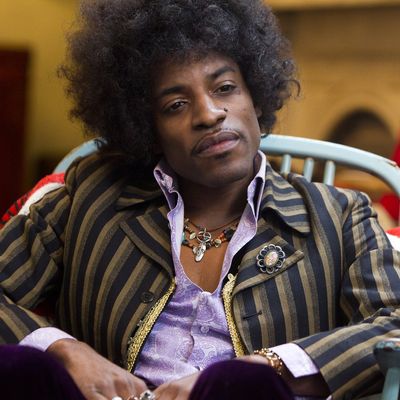
With Jimi: All Is By My Side, writer-director John Ridley tries to do for the rock biopic what Jimi Hendrix did for rock ÔÇÿnÔÇÖ roll itself in the 1960s ÔÇö explode it, redefine it, and help it find its best self. Ridley, who won an Oscar last year for writing 12 Years a Slave, seems to understand the pitfalls of this overdone subgenre. You can feel him looking for ways to avoid regurgitating the standard biographical details, the usual career high points and personal low points.
The film starts backstage at the Savile Theater in 1967, in the midst of the guitaristÔÇÖs rise to fame in London, before flashing back to Greenwich Village a year earlier, when Hendrix (Andr├® Benjamin, of Outkast, doing solid work) was performing to uninterested, distracted audiences as a member of Curtis Knight and the Squires. Practically every rock-star biopic seems to begin this way ÔÇö think of Walk the Line kicking off with Johnny Cash performing at Folsom Prison before flashing back to the singerÔÇÖs childhood, or Get On Up starting with James BrownÔÇÖs 1988 arrest before jumping back in time. But Ridley does something slightly unfamiliar with a familiar structure: By going back just one year, he announces that heÔÇÖs not that interested in the usual childhood traumas (though God knows Hendrix had his share). Jimi: All Is by My Side is fixated on the year that saw Hendrix go from being a nobody in the U.S. to an icon in the U.K. ThatÔÇÖs another way of saying that the film is more interested in the art itself than the life.
Ridley clearly wants to find a cinematic way to capture HendrixÔÇÖs style ÔÇö the way that seemingly unfocused toying around on the guitar would become an electrifying, sinewy jam. ÔÇ£ItÔÇÖs just colors, thatÔÇÖs it,ÔÇØ Jimi says at one point, describing his music. Ridley goes for something similar ÔÇö though in his case, itÔÇÖs more impressionistic than psychedelic. He keeps his camera close, riffing on glances and little details that serve more to create atmosphere than to tell a story. Practically every scene has people softly chattering away in the background or a TV on, lending the whole movie a trippy vibe. The filmÔÇÖs insistence on texture and mood recalls Michael MannÔÇÖs Ali, or (a more extreme example) Peter WatkinsÔÇÖs Edvard Munch.
And the film is indeed at its best when immersed in the art itself: When Chas Chandler (Andrew Buckley), the Animals bassist who would later become his manager, first sees Hendrix play, the music on the soundtrack cuts out, and all we hear are the little squeaks of fingers dancing across the frets. For an instant, weÔÇÖre in the mind of a fellow musician, sensing the craft at work, understanding that this Hendrix kid isnÔÇÖt just inspired, heÔÇÖs got skill, too. Later on, an expensive recording session that never seems to get off the ground, thanks to random interruptions and HendrixÔÇÖs own casual approach to things, conveys both the weirdness of trying to put such an experimental and intuitive performer in a studio as well as the mysterious, formless beauty of his music.
If Jimi: All Is by My Side doesnÔÇÖt always work, itÔÇÖs because under that modest veneer, it actually tries to do a little too much. RidleyÔÇÖs heart is in the art, but he is ultimately too dutiful to the particulars of HendrixÔÇÖs life and career in this period to really go for something special. Much of the film is about the musicianÔÇÖs romantically fraught friendship with Linda Keith (Imogen Poots), Keith RichardsÔÇÖs then-girlfriend, and his troubled romance with his own girlfriend, Kathy Ethingham (Hayley Atwell). Even so, narrative information is kept to the barest essentials: When characters show up, theyÔÇÖre usually announced with quick little title cards ÔÇö ÔÇ£Keith RichardsÔÇØ or ÔÇ£Andrew Loog Oldham, manager of the Rolling StonesÔÇØ ÔÇö thus obviating the need to set them up or spend time explaining why theyÔÇÖre there.
ItÔÇÖs a catch-22, of course. How much referencing of HendrixÔÇÖs life is too much? DonÔÇÖt we want to know something about his childhood? Ridley does give us a painful phone call the rocker makes to his estranged father, who pretends first not to know him, then insults him. It feels like a scene that belongs in a different movie. But if it wasnÔÇÖt there, would I be here saying that the film didnÔÇÖt give me enough of a sense of where Hendrix came from?
And what do we do about the whole race issue? Hendrix himself mostly avoided it, having grown up a fan of white and black musicians alike. In London, he meets Michael X, the notorious Black Power activist, who tries to spark Jimis race consciousness. I dont break it down like black England, white England, Hendrix protests. But it is like that. They break it down for you  Youll never be nothin to them but a curiosity, their electric wog, Michael X replies. Its a compelling scene, but again, it feels somewhat adrift in this particular film.
ThereÔÇÖs a halting, fractured quality to All Is by My Side. You can sense the movieÔÇÖs desire to break free of the demands of the rock biopic, but you can also sense it constantly being pulled back. Maybe thatÔÇÖs the point ÔÇö that the tragic HendrixÔÇÖs own flights of artistic fancy were constantly pulled back to earth by the necessities of living in a very specific time and place, one where the police looked on him with suspicion and where the music industry was still bound by petty rivalries and noxious jealousy. So perhaps that uneasy feeling that Ridley hasnÔÇÖt reconciled his two impulses ÔÇö the impressionistic, and the coldly narrative ÔÇö is intentional. But ultimately, those impulses seem to be at war with one another in this fascinating, perplexing film.


